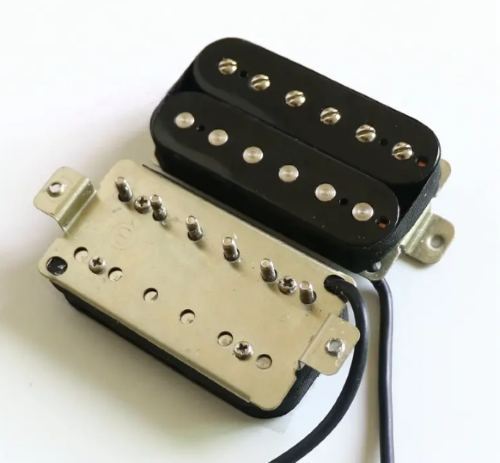
Alnico pickups are a type of electric guitar or bass pickup that uses an alloy of aluminum, nickel, and cobalt—known as Alnico—as the magnetic material. These pickups are prized for their warm, smooth tone and are often associated with vintage-style guitars and classic rock music.
Alnico magnets play a key role in shaping the sound of these instruments, giving them a distinctive character that appeals to musicians across various genres.

The Alnico Alloy
Alnico, the material used in these pickups, is a blend of several metals:
- Aluminum (Al): Adds lightweight properties and improves corrosion resistance.
- Nickel (Ni): Enhances the magnetic properties and stability.
- Cobalt (Co): Increases the magnetic strength and stability at high temperatures.
The exact ratio of these metals can vary, and manufacturers often produce different grades of Alnico, each offering its own unique tonal characteristics. The common grades are Alnico 2, Alnico 3, Alnico 4, and Alnico 5, with Alnico 2 being the softest and most mellow, while Alnico 5 is the strongest and brightest.
Further reading: Comparing Alnico Pickup Magnets: A Comprehensive Overview
How Do Alnico Pickups Work?
Pickups are essentially magnets that convert the vibration of the guitar strings into an electrical signal, which is then amplified through a speaker. Alnico pickups work by creating a magnetic field around the guitar strings. When the strings vibrate, they disturb the magnetic field, inducing a current in the coil of wire wrapped around the magnet. This current is what generates the electrical signal sent to the amplifier.

Characteristics of Alnico Pickups
- Warm and Balanced Tone: Alnico pickups are known for their warm, rich sound, with a smooth high end and tight low end. They often provide a more natural and organic sound compared to modern ceramic pickups, which tend to be sharper and more aggressive.
- Dynamic Response: Alnico pickups are responsive to changes in playing dynamics. Whether you’re playing softly or picking hard, the pickup’s tone adjusts to reflect your touch, which makes them popular among expressive players.
- Vintage Sound: The warmth and complexity of the Alnico sound is often associated with vintage guitars, particularly models from the 1950s and 1960s. This tonal quality is sought after in many genres, including blues, jazz, and classic rock.
Types of Alnico Pickups
There are several configurations of Alnico pickups, the most common being single-coil and humbucker pickups:
- Alnico Single-Coil Pickups: These pickups have a single magnet coil and are known for their bright, crisp tone. Famous guitars like the Fender Stratocaster are equipped with single-coil pickups made from Alnico magnets. Single-coil pickups produce a sharp, clear sound that cuts through the mix but can sometimes pick up more electrical noise or hum.
- Alnico Humbucker Pickups: Humbuckers are designed to cancel out hum and electrical interference by using two coils wired in opposite directions. Alnico magnets in humbuckers can produce a slightly warmer and thicker tone compared to single-coils. Guitars like the Gibson Les Paul are known for using humbuckers with Alnico magnets, which contribute to their signature fuller sound.
Applications of Alnico Pickups
Alnico pickups are commonly found in:
- Electric Guitars: Particularly in models aiming to achieve a vintage sound.
- Bass Guitars: Offering a smoother, more rounded tone than other types of pickups.
- Custom Builds: Musicians and luthiers often opt for Alnico pickups when crafting custom instruments to achieve a specific tonal character.
Conclusion
Alnico pickups are an essential component in shaping the sound of many iconic electric guitars and basses. Their warm, vintage sound and dynamic response make them a popular choice for players seeking tone with character and nuance. Whether you’re a classic rock enthusiast or a jazz guitarist, Alnico pickups can provide the depth and richness that define a truly remarkable instrument. For more magnet materials, please check Stanford Magnets.
